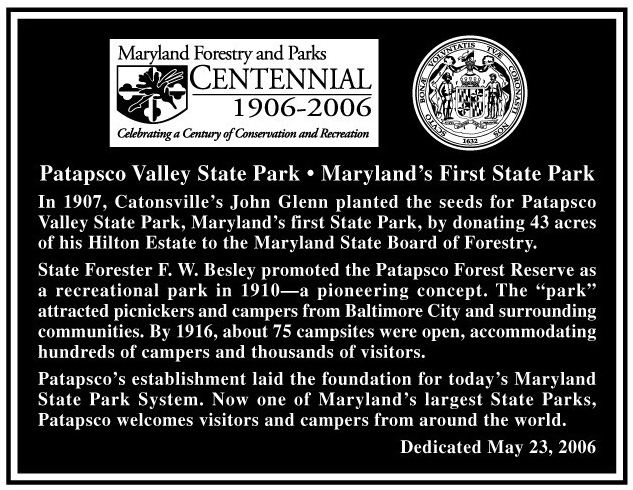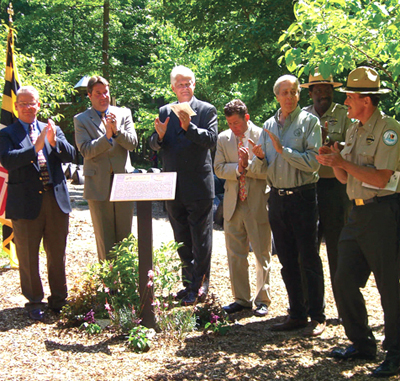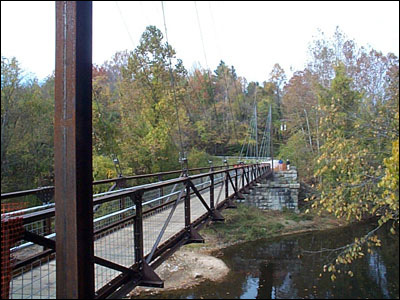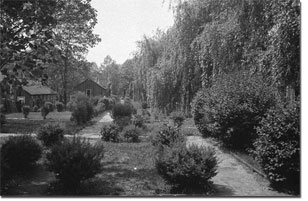Patapsco Valley State Park - Maryland's First State Park
Plaque Dedication - May 23, 2006


Pictured (l to r): DNR Secretary C. Ronald Franks, State Delegate James Malone, State
Delegate Steven DeBoy, Assistant Secretary for Resource Conservation Mike
Slattery, Mr. Kirk Rodgers (grandson of Fred W. Besley), Park Manager
Captain
Gary Burnett and Maryland Park Service Superintendent Colonel Rick Barton with
newly dedicated plaque.
Dedication of the Plaque
Recognizing Patapsco Valley as Maryland’s First State Park
The Maryland Park Service dedicated a plaque in the Hilton area of the park on
Tuesday, May 23rd, 2006. It recognizes Patapsco Valley State Park as Maryland’s
first state park. After welcoming remarks by Captain Gary Burnett, the park’s
manager, guest speakers included C. Ronald Franks, the Secretary of the Maryland
Department of Natural Resources, Paul Farragut, President of the Friends of
Patapsco Valley State Park, and Robb Bailey, Maryland Park Ser-vice Historian.
Offutt Johnson, a retired park naturalist, portrayed Fred W. Besley, Maryland’s
First State Forester and told those assembled how it was back in those early
days. After the plaque was unveiled, Colonel Rick Barton, the Superintendent of
the Maryland Park Service gave the closing remarks.
The plaque is located adjacent to the tire playground near the restrooms. It has
the great seal of the State of Maryland on the upper right and the Maryland
Forestry & Parks Centennial 1906-2006 logo on the upper left. The inscription
reads as follows, “Patapsco Valley State Park – Maryland’s First State Park…In
1907, Catonsville’s John Glenn planted the seeds for Patapsco Valley State Park,
Maryland’s First State Park, by donating 43 acres of his Hilton Estate to the
Maryland State Board of Forestry. State Forester F.W. Besley promoted the
Patapsco Forest Reserve as a recreational park in 1910 – a pioneering concept.
The “park” attracted picnickers and campers from Baltimore City and surrounding
communities. By 1916, about 75 campsites were open, accommodating hundreds of
campers and thousands of visitors. Patapsco’s establishment laid the foundation
for today’s Maryland State Park System. Now one of Maryland’s largest State
Parks, Patapsco welcomes visitors and campers from around the world. Dedicated
May 23, 2006.”
New Bridge on the Grist Mill Trail
A new pedestrian bridge over the Patapsco River completes the 1.25 mile Grist Mill
Trail Extension, a multi-purpose trail that provides ADA accessible access into
the Patapsco State Park from Ellicott City, Catonsville and other upstream
communities for the first time since Agnes struck in June of 1972 and wiped out portions of River Road, eliminating the
Howard County connection to the Park.
The new bridge in the Orange Grove area of the park, crossing the Patapsco River at the location of the old
Patterson Viaduct, connects the Baltimore County side of the river to the Howard
County side. The suspension bridge is approximately 200 feet long and is
designed for pedestrian and bicycle traffic only (motorized vehicles are
prohibited). Bikers and hikers can now cross the river without having to
make a long detour. The new bridge was actually built in the state of
Washington. It was shipped cross-country in several sections and then assembled
on site. An official dedication ceremony was held on November 4, 2006.

The Friends of the Patapsco Valley and Heritage Greenway, in
cooperation with Patapsco State Park, DNR and Howard County Tourism
celebrated the completion of the Grist Mill Trail Extension and its pedestrian bridge on Sat., Nov. 4, 2006
as part of DNR' Centennial Year Celebration.
The Grist Mill Trail is a paved pathway in the Avalon area of the Patapsco State
Park. It is located along the eastern or Baltimore County side of the Patapsco
River from near "Lost Lake" upriver to the Swinging Bridge. The paved portion is
eight feet wide and there is a 2 to 3 foot gravel horse path, which runs along
the length of the trail. The trail is approximately 1.4 miles long and it is
"ADA" or "handicapped accessible".
The
Bigger Picture - Patapsco
Heritage Trail
The Patapsco Heritage Trail is
envisioned to be an on/off road trail that connects Ellicott
City/Catonsville to the BWI Regional Trail System.The BWI regional
trail system in turn connects BWI to the Annapolis area where the
regional trail connects to two national trails - the East Coast
Greenway running North-South from Calais, Maine to the Florida Keys
and the American Discovery Trail running East-West from Lewes,
Delaware to Point Keyes in California. The on-road sections of the
Patapsco Heritage Trail are back country roads to the North and
South of the Avalon section of the Patapsco State Park. These roads
follow along the Patapsco River from Ellicott City to Elkridge. The
trail follows the Grist Mill Trail and its recently completed
extension with the Park. For more information, visit
www.patapscoheritagegreenway.org/
Celebrating the Centennial of Forestry and Parks in Maryland 1906-2006
Maryland was a leader among the states in establishing a program of forest
conservation, and out of that forest conservation initiative, Maryland’s system
of state parks emerged almost immediately. In 1906, philanthropist brothers John
and Robert Garrett challenged the state to establish a forestry program by donating
nearly 2000 tree-stripped acres of land in Garrett County to the state on the
condition that the state establish the governmental machinery to promote wise
use of forest resources.
At that time, Maryland’s tree cover had been reduced
from nearly 90 percent of its land surface when the first colonists arrived to a
paltry 35 percent. Maryland was running out of wood, losing wildlife habitat,
suffering the ravages of erosion and stream siltation, and being scourged by
unchecked forest fires.
The state legislature, spurred by Senators William
McCulloh Brown and Joseph B. Seth, with the aid of State Geologist W. Bullock
Clark, responded with Maryland’s first forestry law, which Governor Edwin
Warfield signed into law on April 5, 1906. Maryland was thus the third state in
the union, preceded by Pennsylvania and Wisconsin, to establish a statewide
forestry program. The law established a Board of Forestry, made up of
influential Marylanders, to oversee the management of the Garrett bequest, to
institute a statewide program of forest conservation, to accept additional land
donations, and to hire a state forester. Acting upon the board’s recommendation,
Governor Warfield appointed an able young forester working for the U.S. Forest
Service, Fred W. Besley, who would serve as Maryland’s first State Forester from
1906 until 1942. A Yale School of Forestry trained protégé of Gifford Pinchot,
first U.S. Forester Besley proved to be an able and energetic choice.
Besley realized almost immediately that one good way to promote the forestry
agenda was to encourage the public to use forest reserves for recreational
purposes. When, in 1907, John Glenn, a resident of Catonsville, donated the beginnings
of another forest reserve along the Patapsco River near Baltimore, Besley saw
the opportunity to entice Baltimore area residents to come recreate in the
great out-of-doors, and by 1910 was informally calling the Patapsco Forest
Reserve “Patapsco Park.” By 1912, Besley had developed a small recreation area
along the river, and by the middle of the decade, people were flocking out of
Baltimore to picnic, swim and camp at the “park.” Now a 14,000 acre, 32 mile
long stretch of public land, Patapsco Valley State Park hosts over a half
million visitors a year.
Besides establishing additional forest reserves and
parks, Fred W. Besley taught forestry practices at the University of Maryland
and established the first state tree nursery there. He also traveled, in his
words, “every cow path in Maryland” producing a comprehensive inventory of all
tree stands in the state that exceeded 5 acres. He gave illustrated talks to
farmers, lumbermen, public service groups, and to anyone who would listen, on
the benefits of wise forest management. He and his small staff provided advice
to wood lot owners on how best to manage their forest re-sources, and created a
roadside tree program to beautify Maryland’s growing network of public highways.
Most significantly, Besley created a staff of over 300 volunteer forest wardens,
along with a network of more than 40 fire towers, across the state to
reduce the incidence of forest fires, an effort at which the wardens succeeded
splendidly. After the legislature started providing money for forest reserve
acquisition, Besley purchased historic Fort Frederick, a relic of the French and
Indian War (1756-1763), which, like Patapsco, was informally known as a park.
He thus earned the gratitude of people who wanted the ruined fort preserved in
the public interest. With the acquisition of state-owned forest lands came the
necessity of paid employees to watch over it.
By 1916, Besley had two salaried
“resident forest wardens” on duty, Edmund G. Prince of the Patapsco Reserve and
Abraham Lincoln Sines of the Potomac Reserve (now Garrett State Forest in
Garrett County). As more lands were acquired, with some dedicated for
recreational use, it eventually became necessary to hire forest and park guards
to assist the wardens with protecting the resources and assisting the public in
the use and enjoyment of forests and parks. Out of this early workforce has
grown today’s force of professional resource managers, forest and park rangers,
technicians, conservation aids and other forest and park resource specialists.
The Great Depression of the 1930s, as devastating as it was to the nation as a
whole, proved a boon to forest and park development. One of President Franklin
D. Roosevelt’s New Deal programs was the Civilian Conservation Corps, which, in
Maryland, put 30,000 young unemployed men to work reclaiming forest and other
natural resources, building recreational facilities and restoring historic
structures on public lands. Most of the recreational facilities that the CCC
built in Maryland forests and parks are in use today. Besley later stated that
all the good works of the CCC set Maryland’s forests and parks ahead by 20 years.
The CCC and
Patapsco State Park

(now known as Patapsco Valley State Park)
Conservation efforts began in the river valley in
1907 when the Patapsco State Forest Reserve was established.
During the Depression years of the 1930s, President Franklin
D. Roosevelt's Civilian Conservation Corps (CCC) planted
trees and built trails, picnic areas, campsites and handsome
cut-stone pavilions to improve what had by then become
"Patapsco State Park".
Company 356 of the Civilian
Conservation Corps made its encampment near Lost Lake at
Camp Tydings in the Avalon Area. The CCC built the stone
picnic shelters in Orange Grove and Glen Artney (not visible
from the river). The CCC was also responsible for planting
trees in the river valley to advance the reforestation
efforts and reclaim the over-used and abused land.
This Civilian Conservation Corps Camp
(CCC) was operational between 1933 and 1942. Following the
start of World War II, the CCC Camp was converted to the
nation's first Conscientious Objector Camp.
During the Second World War, despite the drain of manpower to the military,
public demand for outdoor recreation remained constant, then accelerated after
the war as prosperity returned. Maryland strove to keep up, placing new emphasis
upon carving state parks out of existing state forest land and acquiring new
parks altogether. In 1969, the State established Program Open Space, a dedicated
tax fund that added tens of thousands of new acres to the state’s park system.
Today, Maryland's system of state forests and parks provides over 300,000 acres
of public lands. Eleven million visitors come to these valuable resources each
year and contribute over $300 million dollars to the state’s economy. There is a
state forest or park within 20 miles of every state resident. Both Marylanders
and visitors to the “Old Line State” enjoy a precious outdoor resource thanks to
the farsightedness of Fred Besley and the many other dedicated forest and park
professionals over the past century.
Acknowledgements:
Patapsco Tributary,
Volume 5 Issue 2 Fall & Winter 2006/2007
Friends of Patapsco State Park
Patapsco Heritage Greenway